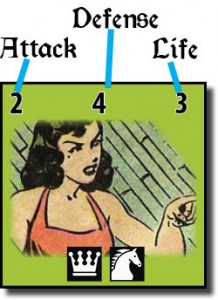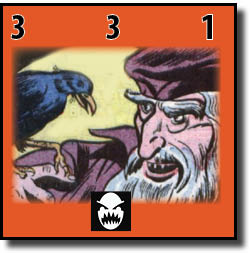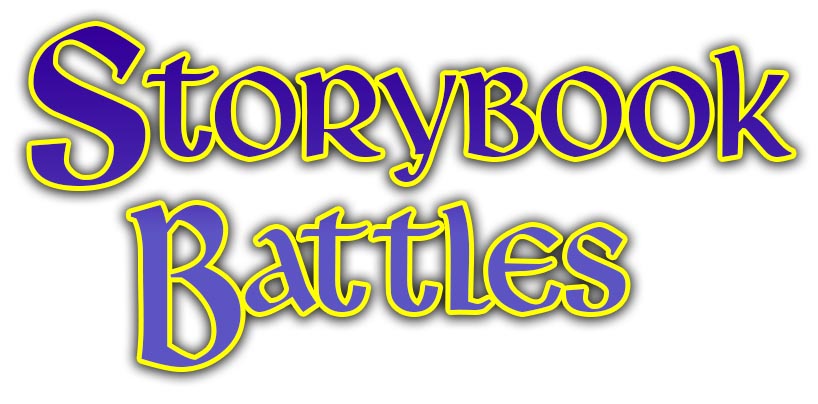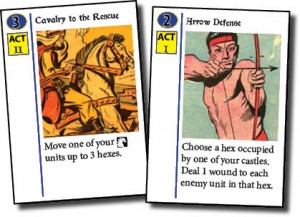Since it worked out so well last time, I decided to give the Ludemic Game Generator another try for this week’s random game. It gave me a rather head-scratching combination of elements:
Categories: Industry / Manufacturing, Fantasy.
Mechanics: Hex-and-Counter, Storytelling.
What’s that? A storytelling fantasy manufacturing game powered by that old standby of war board games, hexes and counters? That is a challenge.
My first thought was a war game with a storytelling aspect to drive the scenarios; sort of a cross between Squad Leader and Once Upon a Time…
…But that felt a little obvious.
My second was to eschew the war game aspect altogether and use the hex-and-counter mechanic to abstractly represent the elements of a story. Different hexes would be different scenes in the story, and the counters represent the characters. Players compete to tell “their” story by moving the characters into the right place in the story…
…But I suspected that something so unintuitive would take more time that I could afford to get it right.
So I’m going with my third idea. It’s a war game with fantasy / fairy tale theme, but the flow of the game is based on the structure of a story, with a defined beginning, a middle, and end. The scenario tells the players how the story begins, but it’s up to the players’ tactical play to tell the rest of the story.
Storybook Battles is a scenario-based war game for two players. But unlike most games in this genre, what actions you can take is determined by where you are in the game. In this way, the game encourages players to make more dramatic, interesting moves in order to tell a dramatic, interesting story.
Components
- Game Board: The game board represents the battlefield where the battle is waged. It’s divided into hexes, and each hex has a type of terrain (forest, plains, mountains, etc.). Some hexes contain castles, villages, and other landmarks as determined by the scenario.
- Unit Counters: Each unit counter has three stats and some number of icons. The stats are Attack, Defense, and Life. The icons have no inherent effect, but allow the unit to be targeted by action cards.
- Action Cards: There are three decks of action cards, one for each act. In order to play a card, you must pay its action cost. You can only play a card during its designated act. Most cards are discarded as soon as you play them.
- Action Counters: These are used to track how many actions you’ve spent this round.
Playing the Game
At the start of the game, set up the board according to the scenario, which tells you what units are on the board, what units are in your reserve, and who goes first.
At the start of the round, each player draws a card and gets a number of action counters determined by the current act:
- Act One: 3 action counters
- Act Two: 5 action counters
- Act Three: 8 action counters
On your turn, you may do one of the following:
- Move: Spend 1 action counter to move any number of your units from one hex into an adjacent hex. A unit can only move once per round.
- Recruit: Put a unit into play from your reserve by spending a number of action counters equal to the number of icons it has. Put that unit into a hex you control.
- Play a Card: Spend a number of action counters equal to the card’s cost. Play it, resolve it, and discard it.
- Special Actions: Scenarios may have special actions you can take, such as “Build a Tower” or “Dig for Treasure” that cost action counters.
Players alternate turns until both players are out of action counters. At that point, the role of first player rotates and a new round begins.
Battle
At the end of the round, if both players have units in the same space, those units battle in a series of battle rounds. During each battle round, the players alternate attacking until all units have attacked.
To attack, choose any number of your units in that hex to be the attackers and one enemy unit to be the defender. If your units’ total Attack is equal to or greater than the defender’s Defense, the defender takes a wound. If the number of wounds it has is at least equal to its Life, the unit is destroyed. After you attack, your opponent attacks.
Each unit can only attack once per battle round. When all units have attacked once, the battle round is over. If both players still have units in the same hex, a new battle round begins. If not, the battle is over.
Act Breaks
 The scenario dictates when one act ends and the next one begins.
The scenario dictates when one act ends and the next one begins.
For example, a scenario may say, “When the Dark Lord player controls seven forest hexes, or the High King player has destroyed 10 enemy units, Act Two begins.”
The scenario also determines any act-based rules changes. For instance, sticking with story structure, I can see a rule where you can’t recruit any new protagonists in the third act.
Game End and Winning
The game ends inside the third act, when the scenario’s victory conditions are met. Each side has its own victory conditions which are mutually exclusive.
Analysis: Game Design Challenges
- I’m Too Hexy for my Act: I haven’t played many hex-and-counter war games, so I suspect there are a lot of conventions that I’m totally missing in this design. That might be okay, but I fear that the rules are too complicated for those more interested in the storytelling aspect of the game and too unusual to appeal to the war gamers. Further research is needed.
- Shakespearean Scenarios: For exciting, story-like games, the scenarios are ideally asymmetrical yet balanced, while offering a dramatic framework that leaves room for players to create their own stories. That seems tricky. Awesome if I can pull it off, but definitely a challenge.
- Diceless Madness: The lack of dice might make things easier (you don’t have to take probabilities into account) but such pure strategy might just as easily lead to analysis paralysis.
Analysis: High Points
- Escalation is Good: Trading card games usually have escalation built into their economies, and board games typically get there too (if more indirectly), but I don’t know off-hand of any war games with this kind of automatic escalation. (I’m sure they’re out there, but I don’t know them.)
- A Storytelling War Game?: This is an unusual mixture of mechanics and theme. If I can get it to work, I think its uniqueness can be a real selling point.
- IP Potential: The storytelling aspect lends itself to a game that emphasizes unique characters. You’re not just moving a unit with a crown and a horse icon, you’re activating Princess Zaya, captain of the Crimson Cavalry. As someone who loves world-building, this is obviously something that appeals to me. Also, this aspect can be adapted to licensed worlds as well. Maybe it’s not Princess Zaya, but Daenerys Targaryen, or Arwen, or Princess Leia on a speederbike.
Here I thought Road Ragers was ambitious. This thing is a beast. I don’t know what the random generators will give me next, but I suspect I’ll be keeping it a bit simpler than this.


